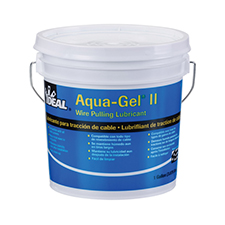
Wax or Polymer – Understanding the Options with Cable Lubricants
Chuck Ross
Wire and cable pulling can be strenuous work, especially when distances stretch several floors or more. Lubricants are an important part of this process – they help reduce friction between cables and conduit, which, in turn, reduces the risk of damage, wear and tear on cable insulators. Lubricants generally fall into one of two categories, wax and polymer. Both types have their advantages, choosing which is right for a specific job depends on several factors.
Wax lubricants have long been a go-to choice for contractors. These products are manufactured using natural or synthetic waxes that are blended with various oils, solvents and additives. They provide good lubricity – basically, slipperiness – while adhering well to wire and cable surfaces, and they stay wet longer than polymers. These characteristics all make wax lubricants a good choice in long runs. They’re also water resistant and biodegradable. They can have a slightly narrower temperature range than polymer products, though.
Polymer lubricants are made from synthetic materials that are blended with various additives to enhance performance. They are easier to clean up and dry more quickly than wax products, making them a good option for shorter pulls that need to be completed quickly.
Most lubricant manufacturers market both wax and polymer products, and their materials can help direct you to which will work better for any given project. Among the issues to look out for is compatibility with specific types of cable jacketing. For example, some wax products shouldn’t be used with low-density polyethylene and semiconducting jackets. And some polymers aren’t compatible with composite rubber cables.
Wax lubricants have long been a go-to choice for contractors. These products are manufactured using natural or synthetic waxes that are blended with various oils, solvents and additives. They provide good lubricity – basically, slipperiness – while adhering well to wire and cable surfaces, and they stay wet longer than polymers. These characteristics all make wax lubricants a good choice in long runs. They’re also water resistant and biodegradable. They can have a slightly narrower temperature range than polymer products, though.
Polymer lubricants are made from synthetic materials that are blended with various additives to enhance performance. They are easier to clean up and dry more quickly than wax products, making them a good option for shorter pulls that need to be completed quickly.
Most lubricant manufacturers market both wax and polymer products, and their materials can help direct you to which will work better for any given project. Among the issues to look out for is compatibility with specific types of cable jacketing. For example, some wax products shouldn’t be used with low-density polyethylene and semiconducting jackets. And some polymers aren’t compatible with composite rubber cables.
Photo courtesy of IDEAL Industries



